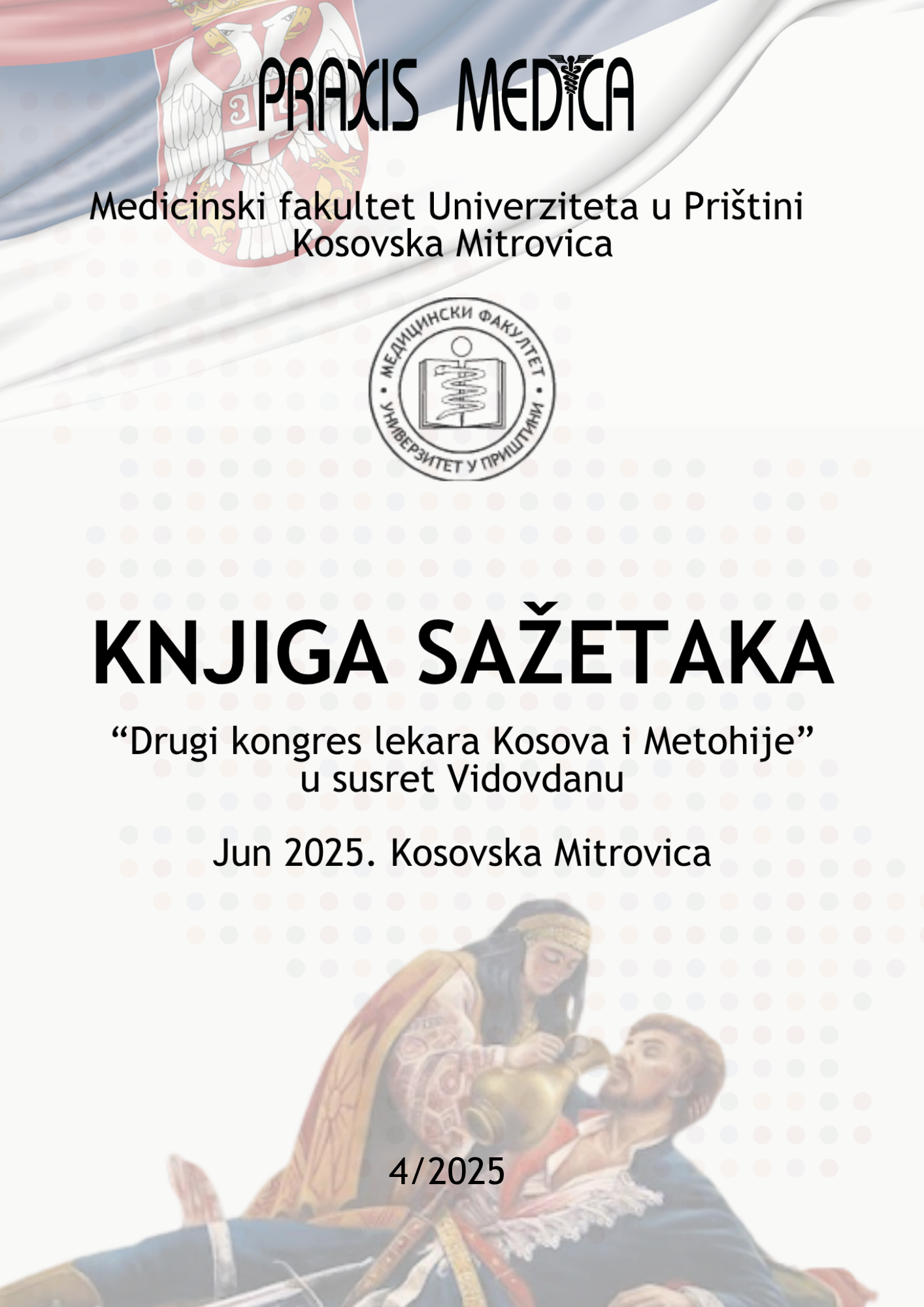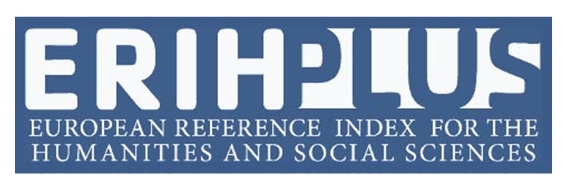Current issue

Volume 53, Issue 4, 2025
Online ISSN: 2560-3310
ISSN: 0350-8773
Volume 53 , Issue 4, (2025)
Published: 30.06.2025.
Open Access
All issues
Contents
30.06.2025.
Professional paper
SRČANA SLABOST I GOJAZNOST
Kao posledica nepravilne ishrane i sedentarnog načina života broj gojaznih osoba dobija epidemijske razmere. Brojne studije pokazuju da je povišen
indeks telesne mase (BMI) nezavistan faktor rizika za nastanak kardiovaskularnih bolesti, uključujući i srčanu insuficijenciju.
Povećanje indeksa telesne mase je udruženo sa povećanim rizikom od pojave srčane slabosti (sistolne i dijastolne) kod osoba oba pola. Naime,
gojaznost je povezana sa češćom hipertrofijom leve komore i njenom dilatacijom, što su prekursori srčanog popuštanja. Usled prisutnog metaboličkog
sindroma kod gojaznih je češća pojava koronarne bolesti. Prevalencija diabetesa, arterijske hipertenzije i hiperlipoproteinemija raste sa porastom
indeksa telesne mase, a oni su faktori rizika za pojavu koronarne bolesti, koja je najčešći uzrok pojave srčane insuficijencije. Pored toga, dijabetes i
arterijska hipertenzija nezavisno povećavaju rizik od nastanka srčane insuficijencije. Povišen BMI udružen je sa izmenjenim remodelovanjem i
hipertrofijom leve komore (verovatno zbog povećanog hemodinamskog opterećenja), neurohormonalnom aktivacijom (povećana simpatička aktivnost,
aktivnost renin-angiotenzin sistema i dr.) i povećanim oksidatvnim stresom. Poslednjih godina ističe se značaj masnog tkiva kao endokrinog organa
koji oslobađa širok spektar biološki aktivnih materija koje mogu imati kardiotoksično dejstvo. Postoji više mogućih mehanizama kojima gojaznost
direktno može dovesti do pojave srčane insuficijencije: gojaznost uzrokuje akumulaciju lipida u ili oko miocita, a oni produkuju lipotoksine sa
direktnim toksičnim efektom na miocite; gojaznost indirektno uzrokuje insuficijenciju desne komore, zbog restriktivne bolesti pluća i poremećaja
disanja tokom sna (sleep apnea); gojaznost je hronično inflamatorno stanje, a inflamatorni citokini mogu narušiti kardijalnu funkciju i/ili izazvati
fibrozu (metaflamacija). Simptomi i znaci SI se naročito teško utvrđuju kod gojaznih, pa se dijagnoza srčane insuficijencije često ne postavlja na
vreme. Gojaznost i terapija srčane slabosti mogu uticati na niže nivoe natriuretskog peptida. Redukcija telesne težine, promena načina života i
ishrane, kao i prevencija dijabetesa kod gojaznih osoba, može značajno redukovati rizik od nastanka srčane insuficijencije. Redukcija telesne težine
dijetom, barijatrijskom hirurgijom ili lekovima (inkretinski hormoni) kod izrazito gojaznih osoba može sprečiti pojavu i poboljšati tok SI. S druge
strane, gojazni, suprotno prvobitnim očekivanjima, često imaju bolju prognozu srčane insuficijencije od negojaznih (obesity paradox). Terapija
srčane insuficijencije kod gojaznih se sastoji iz opštih mera lečenja, medikamentne terapije, invazivnih kardioloških terapijskih mera, kao i hirurškog
lečenja. Primena SGLT2 inhibitora, sakubitril/valsartana i spironolactona imaju posebno povoljan efekat u terapiji srčane insuficijencije kod
gojaznih. Određeni lekovi za terapiju hipertenzije ili dijabetesa, kao što su ACE inhibitori i metformin posebno su efikasni za lečenje i sprečavanje
nekih od posledica ovih bolesti kod gojaznih, a time mogu smanjiti rizik od nastanka srčane insuficijencije. Druga terapija kao što je antiagregaciona
terapija, statini ostvaruju terapijski cilj sprečavanjem nastanka i progresije koronarne bolesti srca,
S obzirom na veliki broj nepoznanica koji prati ovu temu, očekuje se da će buduća istraživanja potpuno razjasniti sve do sada nedovoljno poznate
karakteristike srčane insuficijencije kod gojaznih osoba i da će otvoriti nove terapijske mogućnosti u tretmanu ovih osoba.
Ključne reči: Srčana insuficijencija, gojaznost, rizik, prognoza
Vladan Perić, Marija Stević, Kristina Bulatović
30.06.2025.
Professional paper
KARDIOVASKULARNE BOLESTI KOD STARIH
Starenje je kompleksan biološki, psihološki i socijalni fenomen koji se manifestuje kroz progresivno smanjenje funkcionalnih kapaciteta organizma.
Životni vek se na globalnom nivou povećava, te imamo sve veći broj starih koji obolevaju od kardiovaskularnih bolesti.
SAŽETAK
Učestalost koronarne bolesti se povećava sa starenjem. Promene na krvnim sudovima su difuzne, sa kalcifikatima i češćom zahvaćenošću glavnog
stabla leve koronarne arterije. Kod starijih je češće zastupljen akutni koronarni sindrom bez ST elevacije nego infarkt miokarda sa ST elevacijom.
Teže je otkriti bolest jer je smanjena aktivnost starijih, imaju atipičnu prezentaciju, s dispneom kao glavnim simptomom. Terapiju koronarne bolesti
treba prilagoditi većem broju komorbiditeta. Pacijenti preko 75 godina imaju dvostruko veći mortalitet tokom akutnog infarkta miokarda (češća
srčana insuficijencija, šok, reinfarkt, kao i hronična bubrešna insuficijencija, šlog i ostali komorbiditeti).
Učestalost srčane insuficijencije raste sa godinama starosti (1-2% opšte populacije, 10% kod starijih od 80 godina). Dijagnoza se postavlja teže jer se
usled fiziološkog procesa starenja mnogi ograničavajući simptomi javljaju i u odsustvu srčane slabosti. Kod oko polovine pacijenata postoje simptomi
srčane insuficijencije uz ehokardiografski nalaz očuvane ili blago redukovane sistolne funkcije.
Arterijska hipertenzija se nalazi kod više od 50% osoba starijih od 65 godina i skoro 80% kod starijih od 80 godina, dok se kod opšte populacije javlja u
oko 30%. Kod starijih srećemo povećanje perifernog vaskularnog otpora, smanjenu aktivnost simpatičkog nervnog sistema, smanjenje sentitivnosti
beta receptora i smanjenu aktivnost sistema renin-angiotenzin-aldosteron. Starenje uzrokuje strukturne i funkcionalne promene na velikim
arterijama koje se manifestuju redukcijom njihove komplijanse. Zbog toga kod starijih najčešće srećemo izolovanu sistolnu hipertenziju, znatno
češće u urbanim, nego ruralnim sredinama. Kod starijih se češće sreće pseudohipertenzija - zbog aterosklerotičnih promena nije moguća kompresija
brahijalne arterije pa se mere značajno veće vrednosti sistolnog krvnog pritiska. Kod starijih je česta posturalna hipotenzija. Izbor lekova treba
prilagoditi riziko faktorima, oštećenju ciljanih organa i pridruženim kardiovaskularnim i ne-kardiovaskularnim bolestima koje su česte kod starih.
Najčešća valvularna mana kod starih je senilna kalcifikovana aortna stenoza se sreće kod 21-26% starijih od 65 godina i čak kod 48% starijih od 85
godina. U njenom nastanku glavnu ulogu igraju degenerativni procesi i hronična inflamacija, ako i prisutni faktori rizika (hipertenzija, diabetes,
hiperholesterolemia, pušenje). U lečenju poslednjih godina kod starih primat preuzima transkateteraka implantacija aortne valvule (TAVI procedura).
Učestalost javljanja atrijalne fibrilacije je 5% kod starijih od 65 godina. Njenoj pojavi doprinose ateroskleroza koronarnih arterija, valvularne mane,
hipertenzija i dijabetes, koji su češći kod starijih. Rizik od moždanog udara raste sa 7.3% kod osoba između 60 i 69 godina, na 30.8% kod osoba
starosti 80-89 godina. Zbod toga je veoma važna primena peroralne antikoagulantne terapije.
Zaključak: Kod starijih osoba, kardiovaskularne bolesti su vodeći uzrok smrtnosti, a njihova prevencija i pravovremeno lečenje putem modifikacije
faktora rizika, adekvatne terapije i zdravih životnih navika ključni su za poboljšanje kvaliteta života i dugovečnosti.
Ključne reči: Starost, koronarna bolest, srčana insuficijencija, arterijska hipertenzija, aortna stenoza, atrijalna fibrilacija.
Marija Stević, Vladan Perić
15.02.2025.
Case Reports
IDIOPATHIC PULMONARY HYPERTENSION – CASE PRESENTATION
Pulmonary hypertension (PH) is a hemodynamic condition characterized by a mean pulmonary artery pressure (mPAP) ≥ 25 mmHg at rest, pulmonary arterial wedge pressure (PAWP) ≤ 15 mmHg, and pulmonary vascular resistance (PVR) > 240 dyn·s·cm⁻⁵. The annual incidence of pulmonary arterial hypertension (PAH) is approximately 3–10 new cases per million adults. It is estimated that the prevalence of pulmonary hypertension in individuals over 65 years of age is around 10%.The aim of this study is to present the case of a female patient with progressive dyspnea in whom PAH remained undiagnosed for a prolonged period.A 74-year-old female patient, M.P., was hospitalized in the Coronary Care Unit of the Clinical Center in Kosovska Mitrovica due to symptoms of shortness of breath, choking, fatigue, leg swelling, and weakness. The admission ECG revealed: sinus rhythm, normal axis, high R wave in V2, ST depression, and negative T waves in leads II, III, aVF, and V4–V5. Echocardiography findings showed right ventricular enlargement (2.9 cm), pulmonary artery dilation (3.3 cm), 1–2+ pulmonary regurgitation, and 3+ tricuspid regurgitation, with a systolic pulmonary artery pressure (SPAP) of up to 126 mmHg. The right ventricle measured 5.3 cm in the 4Ch view, with a TAPSE of 1.8 cm. Right heart catheterization revealed the following pressures: PA 78/34/57 mmHg, RV 74/8/10 mmHg, RA 6/6/7 mmHg, CO 4.3 l/min, and LV 99/10/8 mmHg. Although primary pulmonary hypertension is predominantly a disease of younger individuals, it should also be considered in older patients presenting with progressive dyspnea in the absence of structural heart disease.
Kristina Bulatović, Vladan Perić, Maja Šipić, Jovana Milošević, Erdin Mehmedi, Sanja Jovanović
01.12.2020.
Professional paper
Dijabetesna ketoacidoza kod bolesnika sa cerebrovaskularnim insultom - uzroci, mehanizmi, dijagnostika i naše smernice za terapiju
Although cerebrovascular disease may be a well recognised trigger for diabetic ketoacidosis (DKA), literature data on the precise mechanisms, characteristics, or treatment guidelines are rare. The risk of developing an ischemic stroke is doubled in adults with diabetes compared to people with normal glucose metabolism. It is important to point out that even children with DKA have a significantly increased risk of cerebrovascular insult and that they can have a stroke with a frequency of about 10%. Given the significant overlap of symptoms between these two diseases, it can be assumed that attributing DKA symptoms as a manifestation of stroke is not uncommon, especially in elderly and less communicative patients. In addition, pH, bicarbonate concentration, and anion gap are not routinely measured in all diabetics suffering from stroke, at least not in secondary health institutions.Children who develop cerebrovascular stroke during DKA often at the beginning have a preserved consciousness or only mild confusion or lethargy. After a few hours, with the institution of therapy, however, loss of consciousness may occur accompanied by signs of increased intracranial pressure. It was previously thought that the cause was too fast fluid replacement. Recent data suggest that reperfusion injury may be a more likely mechanism. Although most of these studies relate to younger individuals with ketoacidosis, it is clear that at least some of them may be operative in adult DKA. Literature therapeutic guidelines for adult diabetics with stroke-related diabetic ketoacidosis are almost lacking, although it is clear that they could not be the same as those utilised in population with normal glucose metabolism. In this paper, we have tried to define our treatment guidelines for these particular patients.
Aleksandar Jovanović, Vladan Perić, Snežana Marković-Jovanović, Tatjana Novaković, Slavica Pajović, Saša Sovtić, Srbislava Milinić
01.12.2019.
Professional paper
Ebstejn's anomaly in patients perioperative period during a non-cardiac surgery operation
Introduction: Ebstein anomaly, a congenital heart defect characterized by a morphological and functional abnormality of the tricuspid valvula while moving the mouth of the tricuspid valvula towards the apex of the right chamber. Case report: A patient aged 39 years on the Department of Surgery was admitted under the image of an acute abdomen and the need for emergency surgical treatment. Routine preoperative preparation, laboratory treatment, examination of internist and examination of anesthesiologist on the part of the part was carried out. He has a history of occasional breathing problems during respiratory infection, a smoker. Clinical status, other than primary problems, is orderly. Operational treatment passed neatly, on the fourth postoperative day the patient complained of suffocation, lack of air and chest pain, translated into intensive care monitored (spo2 87% f about 110/min TA 90/60), blood gas analysis done and laboratory treatment (fibrinogen, D dimer) due to suspected pulmonary thromboembolia consulted cardiologist, dilation of the right atrium seen by ultrasound. Discussion: Non-cardiac surgeries in patients with pre-existing congenital heart defects are high-risk surgeries with increased mobility and mortality in the perioperative period. In accordance with the accompanying pathoanatomical and pathophysiological changes that define the congenital heart defect, a detailed plan must be made - anesthesiological management for each patient separately. Hemodynamic and respiratory stability with avoidance of hypoxia and paradoxical arrhythmias are the basic postulates in patients with Ebstein's anomaly.
Ljubiša Mirić, Tijana Smiljković, Vladan Perić, Slađana Mirić, Tjaša Ivošević
01.12.2017.
Professional paper
Hiperinsulinemia and ketotic hypoglycemia as the most common forms of hypoglycemic states in childhood
Hypoglycemia is defined asplasma glucose level sufficiently low to result in neurological damage. In the new-born age, the incidence of hypoglycemia ranges from 0.4-11.4%. Etiologically, low levels of plasma glucose can result from the hormonal or metabolic disorders; high doses of insulin, drug poisoning, liver disease or systemic disorders. The most common cause of severe and permanent hypoglycemia in the neonatal age group is congenital hyperinsulinism - the result of pancreatic cells hyperplasia and/or adenoma. Between two and five years of age, the most common form of hypoglycemic state is ketotic hypoglycemia of childhood, caused by limited amount of substrate. Diagnostic criteria include biochemical confirmation of low of glucose and/or high insulin levels, blood hormone testing (epinephrine, cortisol, growth hormone, glucagon levels), as well as metabolic screeningfor gluconeogenesis, glycogenolysis, and lipolysis disorders and disarrangements of fatty acid oxidation. Therapy is directed towards the substrate supplementation and the application of medications and fuels aiming atrapid attainment of normoglycemia (fruit juices, parenterally applied glucose and dextrose, glucagone, corticosteroid therapy); diazoxide and somatostatin therapy is indicated for patients with hyperinsulinemia.
Snežana Marković-Jovanović, Aleksandar Jovanović, Dragica Odalović, Jadranka Mitić, Vanja Nikčević, Perić Vladan
01.12.2016.
Professional paper
Takotsubo cardiomyopathy
Takotsubo cardiomyopathy was described for the first time by Sato in Japan in 1990. It is also called: stress cardiomyopathy, ampulla cardiomyopathy, transient left ventricular apical ballooning syndrome, "broken heart" syndrome and takotsubo-like left ventricular dysfunction. It is characterized by finding of transient abnormal wall motion of the left ventricle, without significant coronary artery stenosis (<50% of lumen), typically accompanied by chest pain, dynamic, reversible disorders of ST-T segment and a slight increase in levels of cardiac enzymes. Previously it was thought that this disease occurs primarily in older women, usually in menopause. With the increase of knowledge and experience about this cardiomyopathy, it is more and more often diagnosed in younger people of all ages, even in younger women during pregnancy or childbirth. Etiology of this disease still remains unknown. The trigger for development of this syndrome is usually, but not always, an intensive emotional or physical stress. Pathogenesis is still not clear enough. There are several pathogenetic theories, and the most widely accepted is a catecholamine theory. It is described seven different types of cardiac dysfunction until now, and the most common are apical akinesia of the left ventricle with a compensatory basal hyperkinesia (classical form), akinesia of the middle part of the left ventricle with preserved ability of contraction in the basal and apical regions (MLV form), biventricular akinesia and isolated right ventricular dysfunction. In this paper are presented the latest findings about this cardiomyopathy, by etiopathogenetic, clinical and therapeutic aspects.
Vladan Peric, Nenad Relic
01.01.2016.
Professional paper
SAPHO syndrome the therapeutical challenge
Introduction: Sapho syndorm is a syndrom characterizing with osteoarticular end dermatologic symptoms. Acronym „SAPHO“ means: S-Sinovitis, A-Acne, H-Hyperostosis, O-Osteytis. SAPHO syndrom has a 50 different names in existing literature. For now, etiology remains unclear, but it belongs to group of seronegative spondylarthropathies. Therapy of SAPHO includes NSAIL, glucocorticosteroids, disease modifying anthireumatic drugs (DMARD), antibiotics, bifosfonatos, and anti TNF - alfa drugs with variable success. Case outline: Pacent P.Z, 47 age, female, comes in the hospital, because of pain in anterior chest, with propagation in right arm, end morning stiffness in sacral part, which passes short after. Also, with recidivant pustules on the palms, bilaterally, which precedes itch. Bone scintigraphy was performed: There is a clear increasing binding of radiopharmacs in projection of strenoclavicular joint, and slightly in both shoulders and both knees. HP: Pustulosis palmoplantaris. We introduced in therapy azithromycin in the dose of 500 mg, two times weekly, for 16 weeks. Patient, one year after, is without relapses of arthritis and skin lesions. Conclusion: This report has goal, to get more knowledge about this rare disease, and to be easier for recognition. Also we want to introduce other physicians, of varying specialities, like orthopaedics, and other surguries, with this disease, not only rheuamatologists, dermatologists, and pediatrics.
Bogdan Dejanović, Gorica Ristić, Vladan Perić, Zlatica Petković, Gordana Nikolić, Ninoslav Dejanović
01.12.2013.
Professional paper
PREDIKTORI POBOLJŠANJA KVALITETA ŽIVOTA ŠEST MESECI NAKON HIRURŠKE REVASKULARIZACIJE MIOKARDA
Prediktori pobolјšanja kvaliteta života nakon hirurške revskularizacije miokarda su još uvek nepotpuno poznati. Cilj rada je bio da ispita prediktore poboljšanja kvaliteta života šest meseci nakon hirurške revaskularizacije miokarda. Ispitivali smo 208 uzastopnih pacijenata koji su podvrgnuti hirurškoj revaskularizaciji miokarda. Za ispitivanje kvaliteta života korišćen je upitnik Nottingham Health Profile Questionnaire prvi deo. Upitnik se sastoji od 38 pitanja koji su podeljeni u 6 odeljaka: fizička pokretljivost, socijalna izolacija, emocionalne reakcije, energija, bol i san. Upitnik je podeljen svim pacijentima pre i šest meseci nakon operacije. Prosečna starost ispitivanih pacijenata je bila 58,8 ± 8,2 godine, 82% su bili muškarci. Poređenje pre i postoperativnih skorova je pokazalo da se poboljšanje nalazi kod 53,76% bolesnika, pogoršanje kod 12,46%, normalan KŽ pre i posle operacije kod 26,70%, dok je KŽ nakon operacije bez promene kod 7,08% bolesnika. Nezavisni prediktori poboljšanja kod pacijenata nakon operacije su bili: odsustvo prethodnog infarkta miokarda u odeljku fizička pokretljivost (p=0,03; OR=0,59; CI 0,40-0,92), viša CCS klasa angine u odeljcima fizička pokretljivost (p=0,006; OR=2,34; CI 1,46-3,32), energija (p=0,02; OR=1,70; CI 1,29-2,64) i bol (p<0,001; OR=4,64; CI 2,27-7,31), muški pol u odeljku bol (p=0,03; OR=0,45; CI 0,26-0,62) i mlađe starosno doba u odeljku bol (p=0,01; OR=0,69; CI 0,41-0,85). Prediktori poboljšanja kvaliteta života šest meseci nakon hirurške revaskularizacije miokarda su viša CCS klasa angine, odsustvo prethodnog infarkta miokarda, muški pol i mlađe starosno doba.
Vladan Peric, S. Sovtic, D. Peric, D. Rasic, Z. Marcetic, S. Milinic, S. Pajovic, G. Nikolic, B. Krdzic, B. Djordjevic, Z. Petkovic, Z. Mihajlovic, M. Popovic, Lj. Smilic, M. Borzanovic





